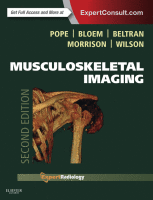Physical Address
304 North Cardinal St.
Dorchester Center, MA 02124

Imaging the postoperative knee can be challenging. The postoperative knee can have all of the pathologic processes of the preoperative knee, in addition to specific issues related to the surgery performed, general problems with surgery, and specific postoperative complications. The…

Postoperative Imaging in Arthroscopic Hip Surgery In recent years, there has been considerable growth in arthroscopic hip surgery as a modality for both investigation and treatment of hip pathology. In this chapter, the postoperative imaging appearances of the hip are…

Elbow, wrist, and hand surgery are frequently done to repair bone and soft tissues, such as fractures and disruptions of ligaments and tendons. Nerves also traverse the area and are released from various tunnels. In this chapter, common indications are…

Recurrent or persistent pain is a common complaint after shoulder surgery. MRI and ultrasonography (US) are often performed in the postoperative setting as a noninvasive means of determining the etiology of postoperative pain. Numerous surgical and arthroscopic techniques are available…

Evaluating the postoperative patient is integral to the practice of musculoskeletal radiology. Most of the subsets of musculoskeletal pathology, including trauma, neoplasia, arthritis, sports medicine, and congenital and developmental maladies, encompass many diagnoses and entities that lead to surgical intervention.…

Classification and Definitions Many different classification systems have been described for spinal deformities. Over the years, some of these classifications have fallen out of favor while new descriptive terms have been applied. To accurately diagnose a spinal deformity, it is…

Achondroplasia Achondroplasia belongs to group 1 of the osteochondrodysplasias, as listed in the International Nosology and Classification of Genetic Skeletal Disorders. It is one of the more common skeletal dysplasias, with a prevalence ranging from 1 : 15,000 to 1 : 40,000 live births.…

Coalition represents abnormal fusion between two or more bones; it occurs more commonly in the bony tarsus but is also seen in the carpal bones. The condition may be congenital or acquired. Coalitions may be complete or incomplete and are…

Etiology and Prevalence Congenital dislocation of the hip is a condition that presents in infancy in approximately 1 in 9000 live births. Although childhood presentation of the condition is uncommon, the occult form of developmental dysplasia occurs frequently. This consists…

Etiology Teratogenic factors due to drugs taken during pregnancy are the best known cause of focal growth disturbances (e.g., thalidomide-associated phocomelia), but sporadic cases of unknown cause are now more frequent. This is due principally to the greater precautions taken…